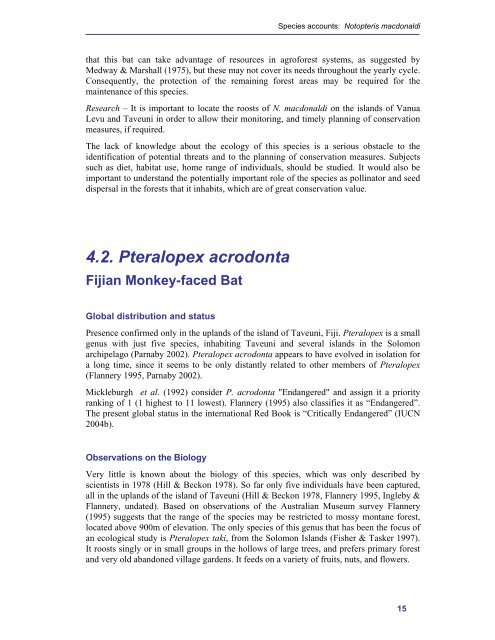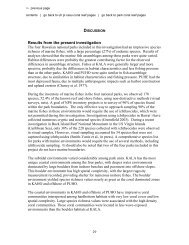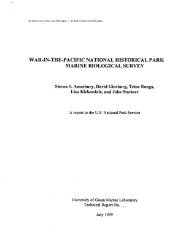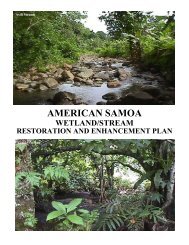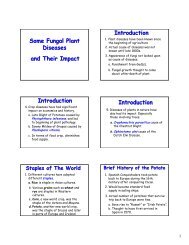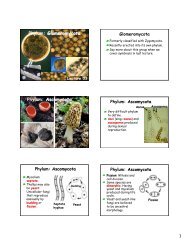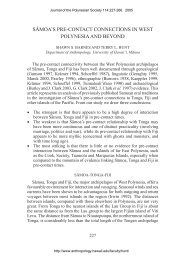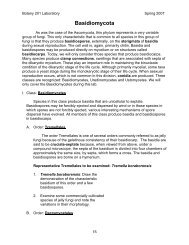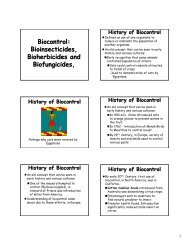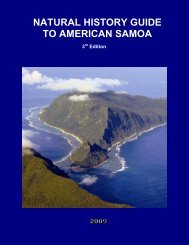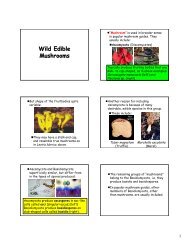distribution, status, and conservation of bats in the fiji islands
distribution, status, and conservation of bats in the fiji islands
distribution, status, and conservation of bats in the fiji islands
Create successful ePaper yourself
Turn your PDF publications into a flip-book with our unique Google optimized e-Paper software.
Species accounts: Notopteris macdonaldi<br />
that this bat can take advantage <strong>of</strong> resources <strong>in</strong> agr<strong>of</strong>orest systems, as suggested by<br />
Medway & Marshall (1975), but <strong>the</strong>se may not cover its needs throughout <strong>the</strong> yearly cycle.<br />
Consequently, <strong>the</strong> protection <strong>of</strong> <strong>the</strong> rema<strong>in</strong><strong>in</strong>g forest areas may be required for <strong>the</strong><br />
ma<strong>in</strong>tenance <strong>of</strong> this species.<br />
Research – It is important to locate <strong>the</strong> roosts <strong>of</strong> N. macdonaldi on <strong>the</strong> isl<strong>and</strong>s <strong>of</strong> Vanua<br />
Levu <strong>and</strong> Taveuni <strong>in</strong> order to allow <strong>the</strong>ir monitor<strong>in</strong>g, <strong>and</strong> timely plann<strong>in</strong>g <strong>of</strong> <strong>conservation</strong><br />
measures, if required.<br />
The lack <strong>of</strong> knowledge about <strong>the</strong> ecology <strong>of</strong> this species is a serious obstacle to <strong>the</strong><br />
identification <strong>of</strong> potential threats <strong>and</strong> to <strong>the</strong> plann<strong>in</strong>g <strong>of</strong> <strong>conservation</strong> measures. Subjects<br />
such as diet, habitat use, home range <strong>of</strong> <strong>in</strong>dividuals, should be studied. It would also be<br />
important to underst<strong>and</strong> <strong>the</strong> potentially important role <strong>of</strong> <strong>the</strong> species as poll<strong>in</strong>ator <strong>and</strong> seed<br />
dispersal <strong>in</strong> <strong>the</strong> forests that it <strong>in</strong>habits, which are <strong>of</strong> great <strong>conservation</strong> value.<br />
4.2. Pteralopex acrodonta<br />
Fijian Monkey-faced Bat<br />
Global <strong>distribution</strong> <strong>and</strong> <strong>status</strong><br />
Presence confirmed only <strong>in</strong> <strong>the</strong> upl<strong>and</strong>s <strong>of</strong> <strong>the</strong> isl<strong>and</strong> <strong>of</strong> Taveuni, Fiji. Pteralopex is a small<br />
genus with just five species, <strong>in</strong>habit<strong>in</strong>g Taveuni <strong>and</strong> several isl<strong>and</strong>s <strong>in</strong> <strong>the</strong> Solomon<br />
archipelago (Parnaby 2002). Pteralopex acrodonta appears to have evolved <strong>in</strong> isolation for<br />
a long time, s<strong>in</strong>ce it seems to be only distantly related to o<strong>the</strong>r members <strong>of</strong> Pteralopex<br />
(Flannery 1995, Parnaby 2002).<br />
Mickleburgh et al. (1992) consider P. acrodonta "Endangered" <strong>and</strong> assign it a priority<br />
rank<strong>in</strong>g <strong>of</strong> 1 (1 highest to 11 lowest). Flannery (1995) also classifies it as “Endangered”.<br />
The present global <strong>status</strong> <strong>in</strong> <strong>the</strong> <strong>in</strong>ternational Red Book is “Critically Endangered” (IUCN<br />
2004b).<br />
Observations on <strong>the</strong> Biology<br />
Very little is known about <strong>the</strong> biology <strong>of</strong> this species, which was only described by<br />
scientists <strong>in</strong> 1978 (Hill & Beckon 1978). So far only five <strong>in</strong>dividuals have been captured,<br />
all <strong>in</strong> <strong>the</strong> upl<strong>and</strong>s <strong>of</strong> <strong>the</strong> isl<strong>and</strong> <strong>of</strong> Taveuni (Hill & Beckon 1978, Flannery 1995, Ingleby &<br />
Flannery, undated). Based on observations <strong>of</strong> <strong>the</strong> Australian Museum survey Flannery<br />
(1995) suggests that <strong>the</strong> range <strong>of</strong> <strong>the</strong> species may be restricted to mossy montane forest,<br />
located above 900m <strong>of</strong> elevation. The only species <strong>of</strong> this genus that has been <strong>the</strong> focus <strong>of</strong><br />
an ecological study is Pteralopex taki, from <strong>the</strong> Solomon Isl<strong>and</strong>s (Fisher & Tasker 1997).<br />
It roosts s<strong>in</strong>gly or <strong>in</strong> small groups <strong>in</strong> <strong>the</strong> hollows <strong>of</strong> large trees, <strong>and</strong> prefers primary forest<br />
<strong>and</strong> very old ab<strong>and</strong>oned village gardens. It feeds on a variety <strong>of</strong> fruits, nuts, <strong>and</strong> flowers.<br />
15


